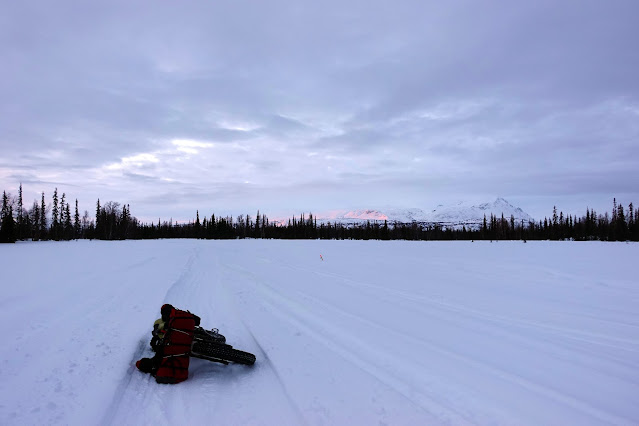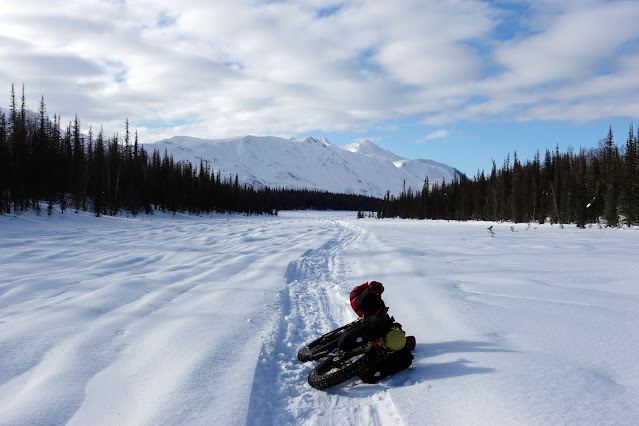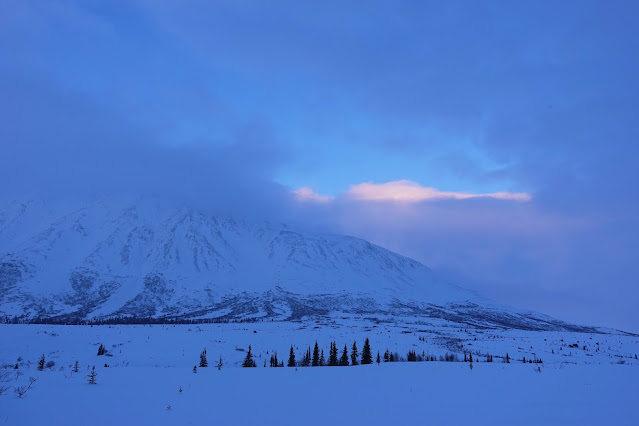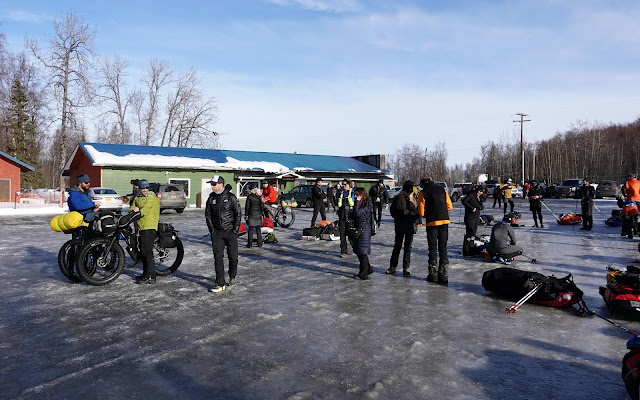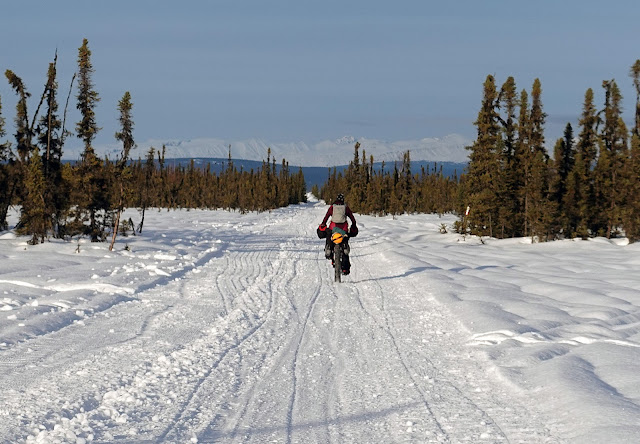The 2022 Iditarod Trail Invitational. Part three of four.
 |
| Gazing back toward Egypt Mountain and a sky streaked with lenticulars. |
Rohn is a friendly place, a strange sort of outpost in Hell. Beneath an old spruce forest at the confluence of two rivers sits a single-wall tent, about the size of a large bathroom, with a portable wood stove and spruce branches stacked to make a bed that covers three-quarters of the indoor space. A race volunteer, Adrien, often waits outside to greet racers with hot bratwurst and as many shots of Fireball whiskey as they'll accept. There’s enough room for five people to lie down on the wet branches, perhaps six if they squeeze.
Rohn is an uncomfortable place to sleep, and it was still early in the evening. But I was frightened about the upcoming crossing on the South Fork of the Kuskokwim River and couldn’t coax myself to leave alone. Bobbette and Becca had arrived about an hour before me and were settling in for a nap. Troy and Bob Ostrom would soon arrive. I laid down with one proverbial eye open, ready to jump up and start packing so I could leave with the group.
 |
| This is a crappy photo I took of the South Fork of the Kuskokwim at 4 a.m. |
The unspoken alarm rang at 3 a.m. The group shoveled in oatmeal and suited up in silence. Bob left first and I followed closely behind him. Troy, Bobbette, and Becca came soon after. We immediately popped out of the woods and descended onto glare ice. The Tatina empties into the South Fork of the Kuskokwim River here, spreading into a wide delta of braided gravel bars and turbulent channels. In early March, it’s one big expanse of black ice. At 4 a.m., this expanse looks and feels eternal.
I hung close to Bob’s wheel as a fierce headwind buffeted our bikes. My studded tires began to slip out; I teetered and slowed just as Bob's bike spun sideways, slamming him into the ice. He quickly stood and said he was okay. The wind was howling; both sky and ground were the deepest shade of black. The horror flick vibe was so visceral that I all but expected a mask-clad murderer to appear on the scene. Indeed, the trail Bob was following dead-ended at the riverbank. An apparently abandoned campsite was strewn with empty fuel cans, shredded canvas bags, and other murder-adjacent trash.
I finally checked my GPS.
 |
| What the South Fork of the Kuskokwim looked like in daylight. Photo by Beth Shaner. |
“We’re going to wrong way,” I announced. “We’ve been riding back up the Tatina.”
Bob thought this was impossible. There was no other trail. But my GPS clearly showed a line heading toward the Dalzell Gorge. We weren’t far from the open channel I’d crossed the previous evening.
Troy turned away to follow a trail cutting farther up the river. I announced I was going back to Rohn. Bobbette, Bob, and Becca followed me. I was shaking with fear and disinclined to become a leader, but I wasn’t willing to leave the comforting purple line of my GPS. Soon we were back at the river bank closest to Rohn, where I located the correct line of snowmachine scratches leading down the South Fork.
As soon as we turned northwest, the headwind became a destabilizing crosswind. My studded tires scratched and slipped along the black ice. The trail scratches didn’t precisely follow my GPS track from the 2020 race, so I occasionally looked up to scan the black abyss for reflective tape or an Iron Dog lath. There were none — likely they’d all been swallowed by the river in an ongoing cycle of overflow and freeze-up. Thin, barely refrozen ice crackled beneath my tires; it was all I could do to focus on my breathing and not erupt into a full panic.
 |
Another daytime shot of the South Fork, showing where the trail leaves the river. You can see a cyclist wading in the background. Photo by Beat Jegerlehner, taken about 12 hours after we crossed.
|
I was still leading when a gust of wind knocked my rear wheel sideways. For a moment I was suspended in eerie silence before a jarring thud echoed in my ears. My body had slammed onto hard ice. Becca wasn’t far behind and rushed toward me because she thought I’d been badly hurt. The fall must have looked bad. My adrenaline was surging and I felt little pain, although later a bruise would spread across my entire left hip and buttock.
As I stood, my headlamp caught a permanent reflector stapled to a tree on the far shoreline about a quarter-mile away. "Finally," I thought. This comforting trail marker indicated the point where we could finally leave the South Fork for good. But my heart sank when I realized that there was nothing between us and the trail marker but the blackest of abysses — no ice to catch a headlamp beam, no gravel bars sparkling with frost. This was all open water.
Four of us sat down on the ice and pulled on our waders. Troy took off in another direction, likely determined to find a better crossing. I still felt strongly that known open water was preferable to unknown ice over potentially deeper channels. Bob went first, wading into water that soon encompassed his thighs. Bobbette and Becca were close behind. I, having struggled with my waders, trailed a bit. I could feel the cold current pressing against my legs as I waded into the channel. The ice underfoot was soft. I carried my bike at shoulder level; the floating tires removed much of the weight, but the wind was strong enough to push it like a sail. To make my balance issues even worse, a strong river current was pushing against my legs from a slightly different direction. The tractionless soles of my waders slipped and I flailed, maintaining my upright position but dunking most of my bike. Luckily, nothing important got wet — I’d waterproofed most of the bags on my bike — but the entire frame was caked with hard ice for much of the day.
At this point, I didn’t care too much about a wet bike or wet legs. I just wanted off the river, by any means necessary.
I followed the group’s exact line but the holes were becoming deeper with each pass. Fast current and the terrible crosswind continued to shove me sideways. Bob climbed up onto the shore; I could see him removing his waders and pouring large amounts of water out of them before I’d even exited the river.
 |
| The group packs up after exiting the river |
The sense of relief I felt when climbing onto the bank was almost overwhelming. I expressed my gratitude to Bob and his willingness to lead. Without the group, I doubt I’d have worked up the courage to face this — the real prospect of a winter swim in Alaska. My greatest adventure fear. At best I would have returned to Rohn and cried until daylight. The group dynamic was empowering.
Bob didn’t seem too fussed that he’d gotten wet. The temperature wasn’t terribly cold — probably about 10 degrees, but the chill became searing in the wind. Troy emerged from the woods and sat down to remove all of the clothing from his lower body. Apparently, he hadn’t found a dry crossing, either.
 |
| Morning swamps north of Rohn |
I took my time removing my waders and was the last to start pedaling again, only to discover my rear derailleur was encased in ice. The gear I was stuck in was “terrified pedal mashing on flat glare ice” — one of the hardest gears. Beyond the South Fork, the trail immediately climbs into the foothills and undulates steeply in and out of drainages all the way to the Farewell Lakes. The trail itself was rippled with icy snowmobile moguls, adding a technical element to the already-steep climbs.
Stuck in high gear, I couldn’t have pedaled much even if my legs were strong. I fell into a morning rhythm of pushing for 10 minutes, stopping to massage the derailleur and cables with my warm hands, blowing a bit of hot air onto the ice-caked cassette, giving up, pushing for 10 more minutes, and rolling down a hill.
My efforts to thaw out my drivetrain seemed futile, but every other time I was able to downshift into a new, lower gear. When this happened I’d praise my bike with vocal encouragement. “Good job! You’re doing great!”
Soon I had broken up enough of the ice to locate the final chunks inside the mechanism. I couldn’t get at them with my hands, so I finally relented to sacrificing my prized possession: the thermos of hot coffee I’d carried from Rohn and intended to consume when the late-morning sleep monster arrived. But my bike needed coffee more than I did.
The hot liquid did the trick; the ice was finally gone and I could shift through all of my gears. “You are the best bike!” I exclaimed in a sing-song voice.
 |
| In a land of swamps, there's no end to the ice |
Dawn light finally appeared along the horizon as I was crossing the Post River, a short but also scary span of glare ice. It was here I first realized the gusting wind was now a tailwind. I hadn’t made much use of it when I was pushing my bike through the woods. The climb away from the Post River is extremely steep. In past years, the trail cut over a veritable waterfall that was colloquially called the Post River Glacier. Crews rerouted the trail to a nearby ridge a few years ago, but the pitch is no less steep and only slightly less icy.
Because the packed snow was almost petrified, I had to veer into deep powder surrounding the trail to gain traction. I was essentially using my legs as anchors, punching a knee-deep hole in loose sugar, digging in with my toes so the leg wouldn’t slip out, then pulling my nearly overturned bike a few inches up the slope. Repeat. The danger of slipping backward or losing my grip on the bike and letting it slide down the hill was pressing enough that my heart was pumping near its maximum just to maintain momentum.
 |
| Arriving at the top of the Post River Glacier, V.2 |
I’d been listening to my iPod Shuffle for most of the morning, since leaving the South Fork at least, to soothe my anxiety. As I was crawling up V.2 of the Post River Glacier, “Wooden Soldiers” by Modest Mouse provided an apt soundtrack.
Modest Mouse is my favorite band of all time; I’ve consumed their music avidly since I was a junior in high school in 1996. It seems that every time I’m working through a particularly volatile period in my life, Modest Mouse releases a rare new album that I will proceed to consume on repeat for months. When I was a high schooler with a faith crisis, my treasured CD was “This is a Long Drive for Someone with Nothing to Think About.” Transitioning from college to early adulthood was “The Moon and Antarctica.” The quarter-life crisis that prompted me to move to Alaska was “Good News for People Who Love Bad News.” Discovering my passion for endurance racing and the subsequent upheavals that led to moving away from Alaska were accompanied by “We Were Dead Before the Ship Even Sank.” Then eight years went by with no new Modest Mouse music. It was a time of relative prosperity for me, but “Strangers to Ourselves” arrived just in time to carry me through my illness during the 2015 Tour Divide and the health challenges that have followed since. Then again, there was no new Modest Mouse until 2021, when “The Golden Casket” dropped just days after my father died.
“The lyrics are kind of depressing,” my friend Danni observed about this album, specifically citing the opening to Wooden Soldiers: “Making plans in the sands as the tides roll in.”
“I don’t see how anyone can make it to middle age and not write depressing lyrics,” I replied.
“Wooden Soldiers” is a wealth of cathartic lyrics that I devoured on repeat during the summer.
"Hashtagging, photo bragging, no one who’s even sorta real
No wonder no one feels better than before."
And a line that reminded me of climbing to White Pine Lake with my friend Raj in July so he could spread his father’s ashes. Raj carried a beautiful earthen pot and showed me the ash and bone fragments inside. When he tossed the pot into a waterfall, I felt an electric tingling in my veins, a whisper of the eternal within this ritual of impermanence.
"In India they make mugs, you throw them down, they turn to mud
Pull it out and make them as they were before."
Yes, "Wooden Soldiers" is a song about despair but also rebirth. As I battled my bike to the top of yet another impossible climb, I was first struck by the hopeful tone at the close of this song.
"It’s level at the peak
Even death just may not be
We’ll cross that bridge sometime and see
But just being here now is enough for me."
Just after I cleared the steepest pitch, my legs began cramping badly. I propped the bike against a tree and sat on the trail. Behind me, thick clouds were beginning to clear, revealing the morning light. The burned forest somehow softened in this violet glow. Views extended to windswept mountains that few ever see. I thought about the rivers surrounding Rohn and how much I hate them. Why do I keep coming back here? I already know too much of the fear and pain. But sometimes, I find myself immersed in immense beauty, the depth of which I don't experience in my comfortable life, where pushing my bike to the top of a hill is so trivial but the withering stare of a stranger can ruin my day. I come here to see through my cracks, to gaze into the void, and embrace my minuscule place in the universe. And although it's impossible to articulate this soaring sense of smallness, a quiet refrain comes close:
"Just being here now is enough for me.
Just being here now is enough for me."
 |
| The perfect flow trail |
Awe revitalized my mind, but my legs wobbled like a newborn moose when I tried to stand. Since incurring a back injury in the October truck collision, I’ve experienced what I suspect to be related neurological symptoms. Hopefully, this is temporary? But sometimes when I sit cross-legged on the ground or bend at my hips while standing, I experience intense tingling and occasional numbness in my legs. This never happened to me before last October. The sensation is jarring enough that it sparks a brief panic as my amygdala prepares for nerve failure and paralysis. My logical brain writes this anxiety off as utterly implausible, but still conjures its own useless command: “Legs this is not a good place to fail.”
 |
| Leaving the mountains behind |
My legs didn’t fail, but between the muscle fatigue and nerve weirdness, I couldn’t have asked for a better place to have a bike in my possession. Where the trail cut through a windswept burn, much of the surface had been scoured to dirt. A tailwind blew with such force that my wheels started rolling before I even threw a leg over the saddle. Suddenly I was screaming through the burned forest, an effortless ride over rocks, roots, and tundra. The route wrapped around Egypt Mountain, a pyramid-shaped summit that stands alone, then plunged toward the Farewell Lakes. I was riding so fast that I momentarily heard nothing of the wind; we were moving the same speed, always the eeriest of silences.
It would be the last time this trail cut me any slack, but it came at the most opportune moment. I was terrified, and then both bike and body were broken, and then, awed by the scope of the landscape, the wind caught my astonishment and carried me effortlessly for 10 miles.
 |
| A lake covered in refrozen overflow and jumbled ice. |
Just when it felt like redemption, I nearly crashed into the shoreline of the first Farewell Lake. A steep descent ended in a jumble of broken ice; the bike bucked sideways as I grabbed the brakes and threw my weight high-side, barely avoiding a header. The tailwind would no longer be my friend.
For the next five miles, the trail crosses lakes and frozen swamps, where much of the surface is glare ice. Recent thaws had flooded the lakes in overflow. Back when the surface was still wet, snowmachines whipped the slush into a bumpy mess. It was all technical and all very slippery. This ice was difficult enough to negotiate without the wind shoving me forward with frequent surprise blasts from the side. And I was lacking a helmet.
After clearing the South Fork of the Kuskokwim, I’d become complacent. No matter what happened now, I had at least passed the last of the “scary” ice. But I felt almost equally unnerved crossing the Farewell Lakes, knowing it wouldn’t take much of a mistake to crack my skull or break an arm. Anxiety begged me to reduce my risk and walk, but my minimally studded boots didn’t provide enough traction on glare ice in this wind. I had to ride. My back muscles were as tight as a steel cable. I was beginning to believe I’d really messed up my back while pushing my bike up Rainy Pass. Adrenaline and then bliss masked the pain all morning, but my entire upper body was sore and my legs were tingling from that weird neuropathic issue. To round everything out, my left hip was painfully stiff after slamming into hard ice on the South Fork that morning. And now I had to somehow propel a heavy bike across this messy nonsense. It was all so risky, and here in the middle of nowhere. If I did break an arm, it seemed unlikely a rescue plane would be able to land in this wind. I’d likely have to wait for a half-day or more for a snowmachine ride (and little did I know at the time, even a ground rescue was nearly impossible at the time, due to trail conditions.)
 |
| I forgot where I found this photo. Taken by someone else, it shows the moguls in the morning. |
To soothe the stress, I daydreamed about the absolute sailing I’d be able to do once I was off the lakes. I couldn’t have been more wrongly optimistic. The moguls began the minute I’d cleared the final lake. Moguls are bumps that form when snowmachines throttle their engines to gain speed, kicking up snow in their wake. This snow gathers in piles, which increase in size as more machines rev their engines to clear the moguls, until the trail is a rippled mess. It’s a similar phenomenon as washboard on a gravel road — but to an extreme. These were some of the worst moguls I’d ever encountered. Each bump was as much as two feet deep and only as wide as a snowmachine track — about 15 inches — with narrow ski tracks forming a rutted high side. It would be one thing if this was packed snow, but a freeze-thaw cycle had encased the moguls in hard ice.
So how to ride the moguls? I am somewhat familiar with pump tracks, although I’ve never ridden one. But I know you must throw your weight into the descents to clear each climb. Not much pedaling can be done. But if you do need to pedal, you’ll only have time for one really hard stroke on the downside of each mogul. This will need to be enough to propel you up the next mogul, some of which are as good as vertical. And when your bike weighs 70 pounds, this needs to be a really hard stroke. I’m thinking 500 watts. Not exactly the kind of power that can be reliably generated by a fatigued 40-something female endurance cyclist with back pain.
The next option was to attempt to ride the ski track to the left. This track was also rippled, but much less so. It was also the exact width of a fat bike tire, so any hairline diversion meant slipping off the track. And if this happened above the trench of the moguls, the dab alone could be a three-foot fall. If my shoulder caught a tree branch near the edge of the trail, it meant tipping over. Same with catching my left pedal on the snow berm. The crashes started within the first mile and only compounded from there.
 |
| A daylight photo of the moguls. Sorry if this is your photo; I didn't take any of my own. |
At first, I was careful, remembering that my unprotected head was skimming within inches of trees. But as frustration and adrenaline surged, I stopped caring. Ongoing crashes continued to pummel me until I felt nothing but rage. Hot, white rage. This rage might have carried me to Nikolai, but then I tipped over and landed on my right hand. The throbbing pain from a wrist that I needed, really needed, whether I rode my bike or pushed it, was the jolt of reality that finally ended this crash bender.
The throbbing subsided and my wrist was okay. At least, it was okay enough to grasp the handlebar and maneuver the bike while walking. Pushing a bike over these ridiculous bumps was hardly easy, but I’d already resigned myself to walking most of the way to Nikolai.
Somewhere in this section, I passed Becca and Bobbette, who were heating up meals for lunch.
“I have forgotten how to ride a bike,” I lamented.
“Us too,” Becca said, although they passed me again 20 minutes later, confirming their skills were better than mine. Between the final Farewell Lake and a remote outpost called Bison Camp are 12 miles of short but steep hills. These hills are utterly endless. I go into this section thinking there are maybe 10 hills and leave convinced there must be 100. I became impatient, and the three of us continued to leapfrog as I commenced my riding attempts.
“Every year, every year, I come to a hill and think this must — MUST — be the last hill. And there are at least 20 more!” I exclaimed breathlessly to Becca. “I am no longer going to tell myself this is the last hill. They will go forever, and I will learn to live this way.”
Becca laughed and said something about how she had Bobbette had been giggling for most of the afternoon. Everything was uproariously funny. That’s what happens to desperate brains, I thought, when forced to either despair or embrace the absurdity. It’s liberating to embrace the absurd.
We both laughed and I suddenly felt 12 years old, the way I felt when sleeping over at a friend’s house. We’d watch a horror film to scare ourselves on purpose, and then we’d stay up all night wandering around the neighborhood, playing small pranks on our neighbors and hoping not to get caught. We were simultaneously frightened and fatigued, exhilarated and exhausted. These sensations were their own kind of high. We craved that intensity. Sometimes, when I’m in the midst of sleep-deprived nonsense that I subject myself to in endurance racing, I wonder if some part of me deep down just wants to be 12 years old again, to again see the world the way I saw it then.
 |
| The top of the final hill, just before descending into the "old" Farewell Burn |
Bobbette and Becca surged ahead before the true final hill. After that, I felt dejected — like the girl at the sleepover who couldn’t stay awake and got left behind. Pain returned to the forefront of my mind. I no longer tried to chase it away. The moguls didn’t end with the hills. If anything, they became worse as the trail cut through a densely wooded area, the regrowth of the “old” Farewell Burn. Later, I heard a rumor that Iron Dog racers created these moguls on purpose to slow down their competitors. The bumps were so bad that locals who need the trails for subsistence hunting couldn’t even use them. Indeed, an ITI cyclist, Lindsay, tore a hamstring in a crash near this location. When Lindsay called (using Beat’s satellite phone) to request a pickup, even with his wife in Canada insisting they would “spare no expense,” it was still a massive undertaking to rescue him. No ITI volunteer had access to a snowmachine that could handle these trails.
 |
| I finally took a good look at my bruises six days later. |
I lost energy for rage and frustration and gave into the long walk. Even hiking was a stumbling, awkward affair, and I noticed my previously broken toe hurt a lot. Had I rebroken it in a crash? I would come to believe this, but I suppose if that’s all that happened, I got away mostly unscathed. However, about six days later, I finally took the time to look at myself in a mirror after a shower and discovered that my entire body was a startling patchwork of black and blue. Even six days later, I looked and felt as though somebody had pummeled me with a small baseball bat.
 |
| A lovely spot for dinner |
Still, I have walked the length of these monotonous spruce swamps many times (well, three times), so despite the pain and mounting boredom, I settled into a pleasant rhythm. And while in my memory I pushed my bike the entire way from Bison Camp to Nikolai, I doubtlessly rode quite a bit, as I made reasonable time. But it was a lot like a terrible night of sleep. Even though many of the hours blur together, you feel as though you were awake the entire night.
I did have one more truly enjoyable hour, about an hour before sunset. I was nearly out of drinking water so I stopped at the shelter cabin turnoff to melt snow and heat up a bag of Chili Mac for dinner. The sun was out and despite a stiff breeze, it felt almost warm, so opted to rest here rather than ride down to the shelter cabin. I hung my ice-crusted waders on the tripod — they actually thawed and nearly dried — and removed my boots and socks to air out my feet in the sunshine. I made a nice chair in a snowbank and sat wiggling my toes in the wind, never wanting to move from this perfect position in paradise.
 |
| Sunset over a swamp. The moguls were not bad in these open areas but returned in force through every forested section. |
The sun set and the light was gorgeous for an hour, and then the forest returned to dark and menacing. I dimmed my headlamp so the shadows on the moguls weren’t quite as dramatic. At some point Troy passed; I had been certain he was ahead and I was the last person out there. His approach through the haunted woods was far too startling. Even when he pulled up beside me I half-believed he was a ghost. Troy was weirdly perky and said something about finding a flow through the bumps. I may have quietly grumbled something about brute force and technical prowess mattering more than Zen mastery. Troy surged ahead; whatever he was doing didn’t look like flow; his bike was bouncing all over the place and he was riding it like a rodeo horse. But he managed the turbulence without tipping over, so I had to concede that Troy had found the answer.
 |
| Sunset south of Nikolai |
My 72-mile “ride” from Rohn to Nikolai encompassed a 22-hour day — up at 3 a.m., into Nikolai at 1 a.m. The only real stop I made was the hour-long dinner break. It would have been a tough day without dumping all of my adrenaline first thing amid the terror of the river crossing, then taking a day-long beating from my bike, and then stumbling into a small village in the middle of the night. I was deeply befuddled and became lost for at least a half-hour while trying to find the checkpoint. I may have wandered around for most of the night if I hadn’t encountered Ethan, who was leaving the checkpoint at that hour and followed my tracks the wrong way up a long hill.
I have doubtlessly described crushing fatigue in many of these race reports, but I swear to you, I have never been so tired in the ITI as I was on this night.

























